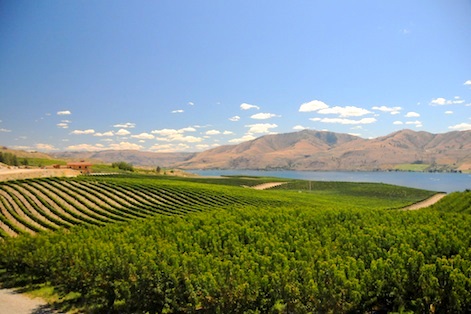
The first vineyards on the banks and bench lands of Lake Chelan were planted in the 1880s by Native Americans (the Wapatos, father and son), who'd been trained in agricultural techniques by an itinerant Jesuit priest, Father Urban DeGrassi. Within a decade, several families of Italian immigrants had claimed homesteads along the lake and were cultivating black muscat, among other grapes. By the 1920s, German wine-growers from the Rhine were also tending vines.
Like many farming pursuits, however, one crop gave way to another. For a time, in the latter part of the 20th century, apple and cherry orchards dominated the landscape, only to give way to "development." Chelan's spectacular mountain setting, midway between Seattle and Spokane, made the lake a magnet for vacationers, retirees, resorts and second homes. But in 1998, two friends, Steve Kludt and Bob Christopher, decided against turning their cherry orchard into condos; they wine grapes instead, and four years later, the Kludt family launched Lake Chelan Winery.
Another winery overlooking the lake is called Tsillan Cellars, echoing the native word tsi-laan, or "deep water." In fact, Chelan's waters are a1most 1,500 feet deep, twice the depth of Lake Okanagan, some 200 miles further north in British Columbia, with a very similar geological history and excellent potential for wine-growing. (Lake Okanagan, on the other hand, is twice as long and has three times the surface.) During the long summer days, the lake acts as a collector of heat, which it then radiates back into the vineyards. In winter, the phenomenon protects the vineyards from frost.
Geologically, the 24,000-acre Lake Chelan AVA differs from the adjoining Columbia Valley AVA because it seems to be unrelated to the glacial Missoula floods. The vineyard soil, in the narrow band of elevation between 1,100 and 1,800 feet, is granitic, covered with coarse, sandy sediment and wind-blown loess. Dr. Alan Busacca, the consulting geologist who wrote the AVA petition on behalf of the Lake Chelan wineries (granted in 2009), says the unique soils give the grapes a distinct minerality and texture.
Sixteen wineries and three vineyards have currently planted 260 acres of vines, producing fine examples of riesling, pinot gris and gewurztraminer as well as syrah and merlot. In the end, what's expected to drive this tiny AVA as much as the wines themselves is Lake Chelan's reputation as one of Washington's most stunning tourist destinations.
Another in a series about Washington State AVAs that ran originally in Edible Seattle. Photo of Benson Vineyards courtesy of the Lake Chelan Chamber of Commerce.
Leave a comment